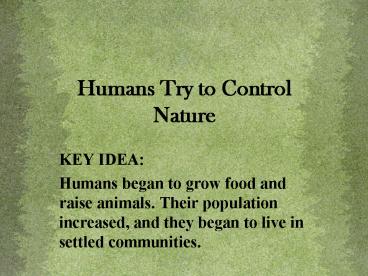Humans Try to Control Nature - PowerPoint PPT Presentation
1 / 23
Title:
Humans Try to Control Nature
Description:
Humans Try to Control Nature KEY IDEA: Humans began to grow food and raise animals. Their population increased, and they began to live in settled communities. – PowerPoint PPT presentation
Number of Views:223
Avg rating:3.0/5.0
Title: Humans Try to Control Nature
1
Humans Try to ControlNature
- KEY IDEA
- Humans began to grow food and raise animals.
Their population increased, and they began to
live in settled communities.
2
Pre-Civilization
- The first humans had faced a struggle for
survival. - For thousands and thousands of years, they were
concerned first with finding food and protecting
themselves from the dangers of life in the wild. - They used fire, built shelters, made clothes, and
developed spoken language.
3
Old Stone Age Hunters- Gatherers
- The people who had lived in the early part of the
Old Stone Age were nomads. They moved from place
to place, never staying in one spot for long. - They were always looking for new sources of food.
They found that food by hunting and gathering
nuts, berries, leaves, and roots. - Human culture changed over time as new tools
replaced old and people tested new ideas.
4
Cro-Magnons Tool Kit
- The Cro-Magnon people, who came later, made tools
to help them in their search. - With spears, hunters could kill animals at
greater distances. With sticks, those who
gathered plant food could dig plants out of the
earth. - These modern humans had a large kit of tools-more
than 100 different ones.
5
Specialization of Tools
- They used stone, bone, and wood. They made knives
to cut meat, hooks to catch fish, and even a tool
to make other tools. - With bone needles, they sewed animal hides into
clothes.
6
Paleolithic Art
- Cro-Magnon people also created works of art. This
art gives us a fascinating glimpse into their
world. - These early humans made necklaces out of
seashells, the teeth of lions, or the claws of
bears. - They took the tusks of mammoths and ground them
down to make beads.
7
Cave Paintings
- The most remarkable art from the Stone Age,
though, is paintings. - Thousands of years ago, artists mixed charcoal,
mud, and animal blood to make paint. - They used this paint to draw pictures of animals
on the walls of caves or on rocks.
8
Vallon-Pont-d'Arc, France 15,000-18,000 BC
9
(No Transcript)
10
Lascaux, France 15,000 B.C
11
The Neolithic Revolution
- Humans lived by hunting animals and gathering
plants for thousands of years. - They lived in small groups of only 20 or 30
people. - They often returned to a certain area in the same
season each year because they knew it would be
rich in food at that time.
12
- Over the years, some humans realized that they
could leave plant seeds in an area one year and
find plants growing there the next year. - This was the beginning of a new part of human
life farming. - This had a HUGE effect on human culture!!!
13
The Ice Sheet Recedes
- Scientists think that the climate became warmer
all around the world at about the same time. - Humans new knowledge about planting seeds
combined with this warmer climate to create what
is called the Neolithic Revolution.
14
Domestication of Animals
- Instead of relying on gathering food, people
began to produce food. - Along with growing food, they also began to raise
animals. They raised horses, dogs, goats, and
pigs.
15
Revolution in Jarmo
- Archaeologists have studied a site in the
northeastern part of the modern country of Iraq.
It is called Jarmo. - The people who lived in this region began farming
and raising animals about 7000 B.C. People were
entering a new age.
16
Villages Grow and Prosper
- People began to farm in many spots all over the
world. Each group developed farming on its own.
Many of the places where farming worked best were
in the valleys of major rivers. - In Africa, people began growing wheat, barley,
and other crops along the Nile River. - In China, farmers began to grow rice and a grain
called millet. - In Mexico and Central America, people grew corn,
beans, and squash. - In the high Andes Mountains of South America,
they grew tomatoes, sweet potatoes and white
potatoes
17
Catal Huyuk
- The study of one village in what is now Turkey
reveals what early farming communities were like.
18
(No Transcript)
19
Specialization of Labor
- Some workers grew wheat, barley, and peas.
- Others raised sheep and cattle. Because these
workers produced enough food for all the people,
others could begin developing other kinds of
skills. - Some made pots out of clay that they bakedthe
first potterywhile others worked as weavers.
Some artists decorated the village.
20
Religion Becomes an Institution
- Archaeologists have found wall paintings that
show animals and hunting scenes. They have found
evidence that the people had a religion, too.
21
(No Transcript)
22
Trade Becomes Important
- Some people in the village worked as traders.
Near the village was a rich source of obsidian, a
stone made from volcanic rock. Pieces of this
rock could be made into a very sharp cutting tool
or polished to be used as mirrors.
23
Disadvantages to Settled Life
- Life in the early farming villages had problems,
too. - If the farm crop failed or the lack of rain
caused a drought, people would starve. - Floods and fires could damage the village and
kill its people. - With more people living near each other than
before, diseases spread easily.































